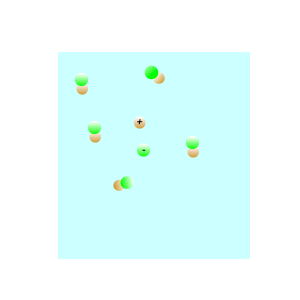Acidity constants and pH
exercises as they appeared in past exams.
A 40 mL acid solution of pH 1 is diluted with 40 mL of distilled water. Another 40 mL acid solution of pH 6 is also diluted with 40 mL of distilled water. Which solution will show the greatest change in pH after the dilution?
The solution of pH 1 contains a strong acid. Strong acids undergo, almost, complete ionisation in water, as they have a high Ka value.
So we could expect to see the maximum number of hydronium ions present.
If the solution is diluted by doubling the volume, surely the
[H3O+] will be halved.

The solution of pH 6 contains a weak acid. Weak acids have a very low percentage ionisation. So at any time we can find the majority of the acid molecules in the unreacted form as shown simply on the right. The following equilibrium is established.
HA(aq) + H2O(l) <=> H3O+(l) + A-(aq)
When the volume is doubled the [H3O+] and [A-]is reduced. Thus the value of the equlibrium expression below is reduced.

The reaction now drives forward to increase the value of [H3O+] and [A-] and restore the value of the Ka. This has the effect of driving the [H3O+] back up and therefore the impact if dilution on the pH as not as great as it would be if a strong acid is involved.
